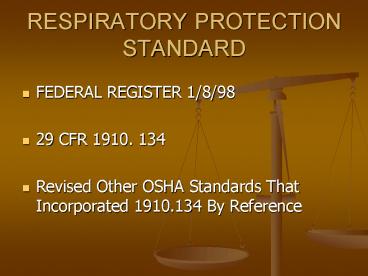RESPIRATORY PROTECTION STANDARD - PowerPoint PPT Presentation
Title:
RESPIRATORY PROTECTION STANDARD
Description:
FEDERAL REGISTER 1/8/98 29 CFR 1910. 134 Revised Other OSHA Standards That Incorporated 1910.134 By Reference DATES EFFECTIVE DATE: APRIL 8, 1998 COMPLIANCE DATES ... – PowerPoint PPT presentation
Number of Views:53
Avg rating:3.0/5.0
Title: RESPIRATORY PROTECTION STANDARD
1
RESPIRATORY PROTECTION STANDARD
- FEDERAL REGISTER 1/8/98
- 29 CFR 1910. 134
- Revised Other OSHA Standards That Incorporated
1910.134 By Reference
2
DATES
- EFFECTIVE DATE APRIL 8, 1998
- COMPLIANCE DATES
- Paragraph (a) September 8, 1998
- Paragraph (b-o) October 5, 1998
3
NEW REQUIREMENTS
- Program Administrator
- Mandatory Medical Questionnaire
- Fit Testing Protocols Specified
- Fit Testing and Training Annually
4
NEW REQUIREMENTS
- More Detailed Written Procedures
- Change Schedule for Cartridges Used for Gas and
Vapors - Breathing Air Quality Specified in More Detail -
Moisture Content etc..
5
APPLICABILITY
- Respirator Use Required If PEL Exceeded
- If Employer Requires Respirator Use Below PEL
- Voluntary Use Below PEL
6
WRITTEN PROGRAM
- Procedures for Selecting Respirators
- Medical Evaluation
- Fit Testing Procedures
- Procedures for Use of Respirators
- Procedures and Schedules for Respirator
Maintenance (cleaning, disinfecting, storing,
inspecting, repairing, discarding)
7
WRITTEN PROGRAM
- Procedures to Ensure Adequate Air Quality
Quantity, and flow of Breathing Air - Training Employees on Respiratory Hazards, Proper
Use, Limitations and Maintenance - Procedures for Evaluating Program Effectiveness
8
RESPIRATOR SELECTION
- Requires use of NIOSH approved respirators
- Provides general guidance for selection
- Must select respirators from a sufficient number
of models and sizes so it fits correctly
9
RESPIRATOR SELECTION
- Non IDLH gases and vapors
- atmosphere supplying or
- air purifying respirator with ELSA or change
schedule - Particulates
- filter certified under 42 CFR 84
10
RESPIRATOR SELECTION
- Respirators for IDLH
- A full face pressure demand 30 minute SCBA
- Combination full face pressure demand
airline/ASCBA - ALL Oxygen deficient atmospheres are IDLH
- Unknown atmosphere IDLH
11
MEDICAL EVALUATION
- Required prior to fit test
- Must be performed by a PLHCP using a medical
questionnaire or exam - Appendix C - Medical Questionnaire
- Follow up exam if positive answer - any tests or
procedures determined by PLHCP
12
MEDICAL EVALUATION
- Provide written procedures, respirator weight,
duration and frequency of use, physical effort
required, temperature and humidity to PLHCP - Written report provided to employer and employee
13
MEDICAL EVALUATION
- Additional medical evaluation required
- employee report
- doctor, supervisor or administrator specified
- observations during fit testing or program
observation - change occurs in workplace
14
FIT TESTING
- Required prior to initial use
- Whenever a different respirator is used
- Annual requirement
- Change in employee physical condition
- Required for all tight fitting respirators
- Follow OSHA Protocol in Standard
15
FIT TESTING
- Qualitative - If PF required less than or equal
to 100 - Quantitative - If PF required more than 100
- Quantitative PF Pass
- 100 for half face piece
- 500 for full face piece
16
USE OF RESPIRATORS
- Prohibits facial hair at the sealing surface or
that interferes with valve function - Must conduct a user seal check (positive and
negative pressure tests) before each use - Procedures in Appendix B
- Procedures as recommended by manufacturer that
the employer demonstrates as effective
17
USE OF RESPIRATORS
- Allows employees to leave the respirator use
area - to wash face / face piece to prevent skin
irritation - if break through, changes in resistance, or face
piece leakage - to replace respirator air purifying element
18
MAINTENANCE
- Cleaning and disinfecting must use procedures in
Appendix B or equivalent provided by manufacturer - Recharge cylinders when pressure below 90
19
BREATHING AIR
- oxygen - 19.5-23.5
- hydrocarbons lt/ 5mg/m3
- carbon monoxide lt/ 10 ppm
- carbon dioxide lt/ 1000 ppm
20
BREATHING AIR
- Compressor air moisture - dew point at least 10 F
below ambient temperature - Cylinder air moisture - dew point less than or
equal to -50 F - Alarms for oil lubricated compressor - CO alarm
set at 10 ppm, high temperature alarm or frequent
monitoring for overheating
21
TRAINING
- Required
- Prior to initial use
- Annually
- Changes in workplace or respirator type
- Employee must be able to demonstrate knowledge
- Why respirator is necessary
- Limitations and capabilities of respirator
22
TRAINING
- How to use the respirator properly
- How to inspect, put on, use, check seal
- Respirator maintenance and storage
- Medical signs and symptoms that may limit the use
of a respirator - Familiar with the general requirements of
1910.134 - Voluntary use - train on Appendix D
23
PROGRAM EVALUATION
- Needed to ensure program is properly implemented
- Employees are to be consulted regularly to assess
their views and identify problems































